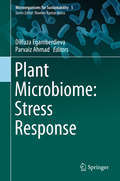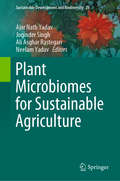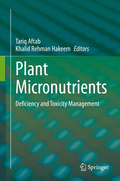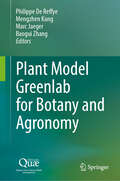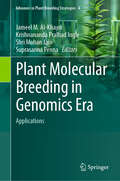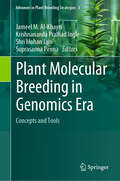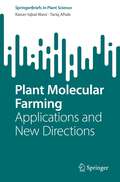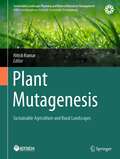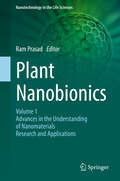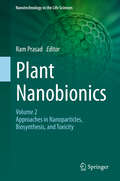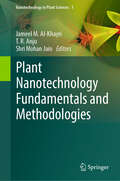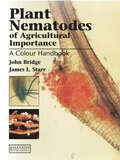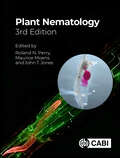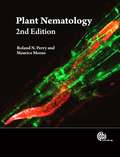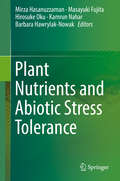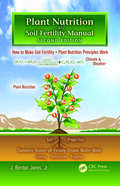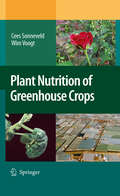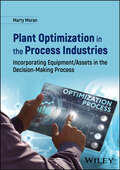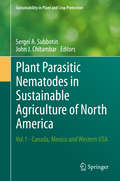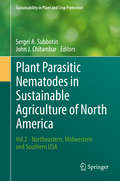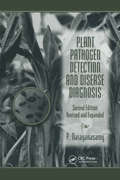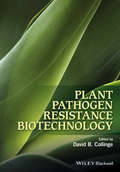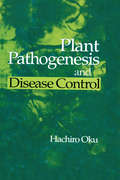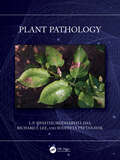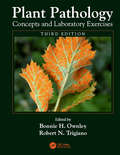- Table View
- List View
Plant Microbiome: Stress Response
by Parvaiz Ahmad Dilfuza EgamberdievaThis book presents state-of-the-art research on the many facets of the plant microbiome, including diversity, ecology, physiology and genomics, as well as molecular mechanisms of plant-microbe interactions. Topics considered include the importance of microbial secondary metabolites in stimulating plant growth, induced systemic resistance, tolerance to abiotic stress, and biological control of plant pathogens. The respective contributions show how microbes help plants to cope with abiotic stresses, and represent significant progress toward understanding the complex regulatory networks critical to host-microbe interaction and plant adaptation in extreme environments. New insights into the mechanisms of microbial actions in inducing plant stress tolerance open new doors for improving the efficacy of microbial strategies, and could produce new ways of economically increasing crop yields without harming the environment. As such, this book offers an essential resource for students and researchers with an interest in plant-microbe interaction, as well as several possibilities for employing the plant microbiome in the enhancement of crop productivity under future climate change scenarios.
Plant Microbiomes for Sustainable Agriculture (Sustainable Development and Biodiversity #25)
by Joginder Singh Ajar Nath Yadav Ali Asghar Rastegari Neelam YadavThis book encompasses the current knowledge of plant microbiomes and their potential biotechnological application for plant growth, crop yield and soil health for sustainable agriculture. The plant microbiomes (rhizospheric, endophytic and epiphytic) play an important role in plant growth, development, and soil health. Plant and rhizospheric soil are a valuable natural resource harbouring hotspots of microbes, and it plays critical roles in the maintenance of global nutrient balance and ecosystem function. The diverse group of microbes is key components of soil–plant systems, where they are engaged in an intense network of interactions in the rhizosphere/endophytic/phyllospheric. The rhizospheric microbial diversity present in rhizospheric zones has a sufficient amount of nutrients release by plant root systems in form of root exudates for growth, development and activities of microbes. The endophytic microbes are referred to those microorganisms, which colonize in the interior of the plant parts, viz root, stem or seeds without causing any harmful effect on host plant. Endophytic microbes enter in host plants mainly through wounds, naturally occurring as a result of plant growth, or through root hairs and at epidermal conjunctions. Endophytes may be transmitted either vertically (directly from parent to offspring) or horizontally (among individuals). The phyllosphere is a common niche for synergism between microbes and plant. The leaf surface has been termed as phyllosphere and zone of leaves inhabited by microorganisms as phyllosphere. The plant part, especially leaves, is exposed to dust and air currents resulting in the establishments of typical flora on their surface aided by the cuticles, waxes and appendages, which help in the anchorage of microorganisms. The phyllospheric microbes may survive or proliferate on leaves depending on extent of influences of material in leaf diffuseness or exudates. The leaf diffuseness contains the principal nutrients factors (amino acids, glucose, fructose and sucrose), and such specialized habitats may provide niche for nitrogen fixation and secretions of substances capable of promoting the growth of plants. The microbes associated with plant as rhizospheric, endophytic and epiphytic with plant growth promoting (PGP) attributes have emerged as an important and promising tool for sustainable agriculture. PGP microbes promote plant growth directly or indirectly, either by releasing plant growth regulators; solubilization of phosphorus, potassium and zinc; biological nitrogen fixation or by producing siderophore, ammonia, HCN and other secondary metabolites which are antagonistic against pathogenic microbes. The PGP microbes belong to different phylum of archaea (Euryarchaeota); bacteria (Acidobacteria, Actinobacteria, Bacteroidetes, Deinococcus-Thermus, Firmicutes and Proteobacteria) and fungi (Ascomycota and Basidiomycota), which include different genera namely Achromobacter, Arthrobacter, Aspergillus, Azospirillum, Azotobacter, Bacillus, Beijerinckia, Burkholderia, Enterobacter, Erwinia, Flavobacterium, Gluconoacetobacter, Haloarcula, Herbaspirillum, Methylobacterium, Paenibacillus, Pantoea, Penicillium, Piriformospora, Planomonospora, Pseudomonas, Rhizobium, Serratia and Streptomyces. These PGP microbes could be used as biofertilizers/bioinoculants at place of chemical fertilizers for sustainable agriculture. The aim of “Plant Microbiomes for Sustainable Agriculture” is to provide the current developments in the understanding of microbial diversity associated with plant systems in the form of rhizospheric, endophytic and epiphytic. The book is useful to scientist, research and students related to microbiology, biotechnology, agriculture, molecular biology, environmental biology and related subjects.
Plant Micronutrients: Deficiency and Toxicity Management
by Khalid Rehman Hakeem Tariq AftabPlants require essential nutrients (macronutrients and micronutrients) for normal functioning. Sufficiency range is the levels of nutrients necessary to meet the plant’s needs for optimal growth. This range depends on individual plant species and the particular nutrient. Nutrient levels outside of a plant’s sufficiency range cause overall crop growth and health to decline, due either to deficiency or toxicity from over-accumulation. Apart from micronutrients (B, Cl, Mn, Fe, Zn, Cu and Mo), Aluminum (Al), cerium (Ce), cobalt (Co), iodine (I), lanthanum (La), sodium (Na), selenium (Se), silicon (Si), titanium (Ti), and vanadium (V) are emerging as novel biostimulants that may enhance crop productivity and nutritional quality. These beneficial elements are not "essential" but when supplied at low dosages, they augment plant growth, development, and yield by stimulating specific molecular, biochemical, and physiological pathways in responses to challenging environments.The book is the first reference volume that approaches plant micronutrient management with the latest biotechnological and omics tools. Expertly curated chapters highlight working solutions as well as open problems and future challenges in plant micronutrient deficiency or toxicity. We believe this book will introduce readers to state-of-the-art developments and research trends in this field.
Plant Model Greenlab for Botany and Agronomy
by Philippe De Reffye Mengzhen Kang Marc Jaeger Baogui ZhangThis book provides a general presentation of knowledge and methods in mathematical modelling and simulation of individual plants. The chapters mainly describe the algorithms of mathematical modelling, simulation and computer visualization and prospective aspects related to future developments of plant models. The book highlights the concepts coming from different disciplines and their mathematical integration to build robust, calibrated, and realistic integrative modeling solutions. Its original and groundbreaking focus is on the integration of structural and functional modeling for a living system such as a whole plant (or a crop field, a forest): most of the time, it has been believed among modeling practitioners that choices have to be made between the two, this belief no more prevails in the era of integrative (well-conceptually grounded) simulations. The content of this book is sufficient for a non-specialist to understand the fundamentals of mathematical modelling of plant architecture. Readers or even software developers can supplement their knowledge by consulting the book.
Plant Molecular Breeding in Genomics Era: Applications (Advances in Plant Breeding Strategies #4)
by Shri Mohan Jain Jameel M. Al-Khayri Suprasanna Penna Krishnananda Pralhad IngleOver the years, the interventions of genomics tools have paved the way for molecular breeding to meet the challenges of food security and climate resilience. Advances in plant molecular breeding encompassing approaches of genomics, molecular markers, genetic transformation and genome editing have revolutionized crop improvement. Successful application of these tools has led to improvement of a wide range of traits of agronomic relevance. This book provides a comprehensive coverage of successful applications of molecular approaches that can be integrated within plant breeding programs aimed at improvement of crop plants. The book covers all relevant areas of molecular breeding applications in plants, with many examples drawn from the advanced genomics and molecular breeding research. Chapters present a critical appraisal of the current literature in the respective fields of molecular breeding written by expert authors. Each chapter provides in-depth discussion of the subject supported with high-quality color illustrations relevant data and future research perspective and, a comprehensive list of pertinent references.
Plant Molecular Breeding in Genomics Era: Concepts and Tools (Advances in Plant Breeding Strategies #3)
by Shri Mohan Jain Jameel M. Al-Khayri Suprasanna Penna Krishnananda Pralhad IngleAdvances in plant genomics, plant molecular biology and genome editing have revolutionized opportunities for more efficient plant breeding. Successful application requires a concrete understanding of the concepts. Molecular Plant Breeding is an interface of issues from basic concepts to applications to crop improvement. The tools include molecular marker technology, gene mapping, genetic transformation, precise gene editing, and climate smart agriculture. This book provides a comprehensive coverage of molecular tools and methodologies that should be integrated within plant breeding programs for the improvement of crop plants. The book covers all relevant areas of molecular breeding in plants, with concepts and tools of relevance to plant genomics research and advanced molecular breeding. Chapters comprehensively review the contemporary literature on the subject and reflect the experiences of the authors. Each chapter emphasizes introduction covering related backgrounds and providesin-depth discussion of the subject supported with high-quality color illustrations and relevant data. Chapters conclude with future research perspective and, a comprehensive list of pertinent references.
Plant Molecular Farming: Applications and New Directions (SpringerBriefs in Plant Science)
by Tariq Aftab Kaiser Iqbal WaniMolecular farming is a biotechnological approach that includes the genetic adjustment of agricultural products to create proteins and chemicals for profitable and pharmaceutical purposes. Plant molecular farming describes the manufacture of recombinant proteins and other biologically active product in plants. This approach depends on a genetic transformation of plants that can be accomplished by the methods of stable gene transfer, such as gene transfer to nuclei and chloroplasts, and unstable transfer methods like viral vectors. The requirement for recombinant proteins in terms of quality, quantity, and diversity is increasing exponentially This demand is traditionally met by recombinant protein construction technologies and the engineering of orthodox expression systems based on bacteria or mammalian cell cultures. However, majority of developing countries cannot afford the high costs of medicine derived from such existing methods. Hence, we need to produce not only the new drugs but also the cheaper versions of those already present in the market. Plant molecular farming is considered as a cost-effective technology that has grown and advanced tremendously over the past two decades. This book summarizes the advances and challenges of plant molecular farming for all those who are working on or have an interest in this rapidly emerging area of research.
Plant Mutagenesis: Sustainable Agriculture and Rural Landscapes (Sustainable Landscape Planning and Natural Resources Management)
by Nitish KumarThis book emphasizes recent developments in the use of mutation technologies for crop plant improvement and, ultimately, sustainable development. Plant breeders use genetic variation, which is created by plant-induced mutation, to create new and improved cultivars. The development of improved cultivars is a productive and optimistic agricultural strategy for economic and environmental sustainability since it ensures high yield stability, enhances soil health, and poses no environmental risks. Understanding mutation induction and exploring its uses have paved the road for improving genetic diversity for different plants and agronomic features and advanced gene discovery for diverse qualities that aid in sustainable development. Plant mutation breeding imitates spontaneous mutation, the primary force driving evolution, by using a plant's own genetic resources instead of genetic transformation. In order to develop beneficial agricultural features, this strategy focuses on the application of various chemical and physical mutagens in conjunction with biotechnologies. In order to survive in challenging environments, increase nutritional value, fight diseases and pests, grow in salty soils, and utilize water and nutrients more effectively, new varieties of plants are developed.This approach has significantly boosted the economies of nations like China, India, Japan, Pakistan, and the USA. As of right now, the strategy has produced and disseminated more than 3600 mutant types in the majority of crop plants, having a significant economic impact. This book discusses several mutation induction techniques, mutant screening, genome editing, the haploid breeding system for mutations, as well as genomic developments, and mutant gene identification. Plant breeders, researchers, and students in the fields of plant sciences, agriculture, and food science will find this instructive book to be of great help.
Plant Nanobionics: Volume 1, Advances in the Understanding of Nanomaterials Research and Applications (Nanotechnology in the Life Sciences)
by Ram PrasadAn improved understanding of the interactions between nanoparticles and plant retorts, including their uptake, localization, and activity, could revolutionize crop production through increased disease resistance, nutrient utilization, and crop yield. This may further impact other agricultural and industrial processes that are based on plant crops.This two-volume book analyses the key processes involved in the nanoparticle delivery to plants and details the interactions between plants and nanomaterials. Potential plant nanotechnology applications for enhanced nutrient uptake, increased crop productivity and plant disease management are evaluated with careful consideration regarding safe use, social acceptance and ecological impact of these technologies.Plant Nanobionics: Volume 1, Advances in the Understanding of Nanomaterials Research and Applications begins the discussion of nanotechnology applications in plants with the characterization and nanosynthesis of various microbes and covers the mechanisms and etiology of nanostructure function in microbial cells. It focuses on the potential alteration of plant production systems through the controlled release of agrochemicals and targeted delivery of biomolecules. Industrial and medical applications are included. Volume 2 continues this discussion with a focus on biosynthesis and toxicity.
Plant Nanobionics: Volume 2, Approaches in Nanoparticles, Biosynthesis, and Toxicity (Nanotechnology in the Life Sciences)
by Ram PrasadPlant Nanobionics, Volume 2 continues the important discussion of nanotechnology in plants, but focuses with a focus on biosynthesis and toxicity. This book discusses novel approaches to biosynthesis of nanoparticles for the increase of plant production systems, controlled release of agrochemicals and management of plant biotic stress. Green biosynthesis of metallic nanoparticles from bee propolis, artificial photosynthesis and hybrid structures are presented.Although engineered nanoparticles have great potential for solving many agricultural and societal problems, their consequences on the ecosystems and environment must be responsibly considered. This volume aims to contribute to the limited literature on this topic through its comprehensive examination of nanoparticle toxicity on plants, microbes and human health. Environmental risks with recent data are discussed as well as risks associated with the transfer of nanoparticles through the food chain. This volume highlights the study of a mechanistic approach and the study of nanoparticles towards nanobionics. The application of polymeric materials for smart packing in the food industry and agriculture sector as well as the future of nanomaterials in detecting soil microbes for environmental remediation are also included.
Plant Nanotechnology Fundamentals and Methodologies (Nanotechnology in Plant Sciences #1)
by Shri Mohan Jain Jameel M. Al-Khayri T. R. AnjuThe book provides an accessible introduction to the core concepts of nanotechnology, the interactions between plants and nanoparticles, and the basic techniques for delivering nanoparticles to plant systems. It offers detailed methodologies and in-depth discussions on the intersection of nanotechnology and plants. The chapters are organized to convey fundamental ideas and provide a comprehensive understanding of plant nanotechnology for readers of all levels. Currently, there is a lack of books addressing interdisciplinary research with a precise overview, and this book can fulfill that demand. The book will serve as a valuable source of fundamental and up-to-date information in the field of plant nanotechnology for graduate students, research scholars, academicians, and scientists from various disciplines.
Plant Nematodes of Agricultural Importance: A Colour Handbook
by John Bridge James StarrThe microscopic soil and plant nematodes that are parasitic on crop plants can be very damaging, and are generally not visible to the naked eye. Their microscopic size means that associating them with crop damage is mainly dependent on determining the symptoms of their effects on plants or plant growth. The damage and symptoms caused can be visible
Plant Nematology
by Maurice Moens Roland N. Perry John T. JonesPlant-parasitic nematodes are a major threat to crop production in all countries, and identification of nematodes and knowledge of their biology is of paramount importance. Providing a broad introduction to nematodes as plant parasites, this book begins by describing nematodes by genera, and then builds on this foundation to detail nematode biology and pest management, including resistance, and biological and chemical control. This 3rd edition is updated to address advances in our knowledge of plant-parasitic nematodes, particularly concerning the molecular aspects of host-parasite relationships, including the application of genomics to nematode biology. Changes in control and management strategies are also covered. The influence of climate change on plant-parasitic nematodes is addressed in a new chapter on ecology. Primarily aimed at students (MSc and PhD), this book is also invaluable for researchers and lecturers in nematology, plant pathology and parasitology, advisory and quarantine services, and crop protection scientists.
Plant Nematology
by Maurice Moens Roland N Perry* Fully updated to take account of the most recent research * Chapters are written by international experts and enhanced by extensive illustrations and focus boxes * Divided into three sections for ease of use
Plant Nutrients and Abiotic Stress Tolerance
by Masayuki Fujita Mirza Hasanuzzaman Hirosuke Oku Kamrun Nahar Barbara Hawrylak-NowakThis book discusses many aspects of plant-nutrient-induced abiotic stress tolerance. It consists of 22 informative chapters on the basic role of plant nutrients and the latest research advances in the field of plant nutrients in abiotic stress tolerance as well as their practical applications. Today, plant nutrients are not only considered as food for plants, but also as regulators of numerous physiological processes including stress tolerance. They also interact with a number of biological molecules and signaling cascades. Although research work and review articles on the role of plant nutrients in abiotic stress tolerance have been published in a range of journals, annual reviews and book chapters, to date there has been no comprehensive book on this topic. As such, this timely book is a valuable resource for a wide audience, including plant scientists, agronomists, soil scientists, botanists, molecular biologists and environmental scientists.
Plant Nutrition and Soil Fertility Manual
by J. Benton Jones Jr.Like all living things, plants require nutrient elements to grow. The Plant Nutrition Manual describes the principles that determine how plants grow and discusses all the essential elements necessary for successful crop production. The nutritional needs of plants that add color and variety to our visual senses are addressed as well. Altogether, nut
Plant Nutrition of Greenhouse Crops
by Wim Voogt Cees SonneveldGreenhouse cultivation is noted for its high uptake of minerals, consistent climatic conditions, exclusion of natural precipitation and control of salt accumulation. Acknowledging that plant nutrition in greenhouse cultivation differs in many essentials from field production, this volume details specific information about testing methods for soils and substrates in a greenhouse environment. It does so while offering a universally applicable analysis. This is based on the composition of the soil and substrate solutions, methods for the interpretation of tissue tests, and crop responses on salinity and water supply in relation to fertilizer application. Fertilizer additions, related to analytical data of soil and substrate samples, are presented for a wide range of vegetable and ornamental crops. The subject is especially apt now as substrate growing offers excellent possibilities for the optimal use of water and nutrients, as well as the potential for sustainable production methods for greenhouse crops.
Plant Optimization in the Process Industries: Incorporating Equipment/Assets in the Decision-Making Process
by Marty MoranOptimize asset decisions and improve the financial and technical operation of process plants The process industries, particularly the refining and petrochemical industries, are comprised of capital-intensive business whose assets are valued in the trillions. Optimizing the function of refining and petrochemical plants is therefore not simply a process decision, but a business one, with even small improvements in efficiency potentially providing enormous margins. There is an urgent need for businesses to assess how the asset side of process industry production can be optimized. Plant Optimization in the Process Industries offers a pioneering asset-focused approach to plant optimization. Optimization of operating values within a processing unit is a developed area of technology with a wide and varied literature; little attention has been paid to the asset side, making this a groundbreaking and invaluable work. Outlining a multi-tiered approach to financial optimization which adjusts the variables of a statistical asset model, this volume has the potential to revolutionize businesses and generate record profit margins. Readers will also find: Comparison and contrast of different technologies on the process and asset side of the industryDetailed discussion of constrained, non-linear optimization technology, along with basic functioning of Monte Carlo modelling A real-world case study followed through the book to facilitate understanding This book is ideal for professionals who manage, design, operate, and maintain process industry facilities, particularly those in the hydrocarbon and chemical industries, as well as any asset-intensive industry.
Plant Parasitic Nematodes in Sustainable Agriculture of North America: Vol. 1 - Canada, Mexico And Western Usa (Sustainability In Plant And Crop Protection Ser.)
by Sergei A. Subbotin John J. ChitambarPlant-parasitic nematodes are recognized as one of the greatest threats to crop production throughout the world. Estimated annual crop losses of $8 billion in the United States and $78 billion worldwide are attributed to plant parasitic nematodes. Plant parasitic nematodes not only cause damage individually but form disease-complexes with other microorganisms thereby increasing crop loss. Nematode diseases of crops are difficult to control because of their insidious nature and lack of specific diagnostic symptoms which closely resemble those caused by other plant pathogens and abiotic diseases. Future developments of sustainable management systems for preventing major economical agricultural losses due to nematodes is focused on strategies that limit production costs, enhance crop yields, and protect the environment. This book presents a first compendium and overview for nematode problems and their management across North America. Each chapter provides essential information on the occurrence and distribution of plant parasitic nematodes, their major crop hosts, impact on crop production and sustainable management strategies for each region of the continent including, Canada, Mexico and all states of the USA. For each region, a thematic overview of changes in crop production affected by plant parasitic nematodes and their management strategies over time will provide invaluable information on the important role of plant parasitic nematodes in sustainable agriculture.
Plant Parasitic Nematodes in Sustainable Agriculture of North America: Vol. 1 - Canada, Mexico And Western Usa (Sustainability In Plant And Crop Protection Ser.)
by Sergei A. Subbotin John J. ChitambarPlant-parasitic nematodes are recognized as one of the greatest threats to crop production throughout the world. Estimated annual crop losses of $8 billion in the United States and $78 billion worldwide are attributed to plant parasitic nematodes. Plant parasitic nematodes not only cause damage individually but form disease-complexes with other microorganisms thereby increasing crop loss. Nematode diseases of crops are difficult to control because of their insidious nature and lack of specific diagnostic symptoms which closely resemble those caused by other plant pathogens and abiotic diseases. Future developments of sustainable management systems for preventing major economical agricultural losses due to nematodes is focused on strategies that limit production costs, enhance crop yields, and protect the environment. This book presents a first compendium and overview for nematode problems and their management across North America. Each chapter provides essential information on the occurrence and distribution of plant parasitic nematodes, their major crop hosts, impact on crop production and sustainable management strategies for each region of the continent including, Canada, Mexico and all states of the USA. For each region, a thematic overview of changes in crop production affected by plant parasitic nematodes and their management strategies over time will provide invaluable information on the important role of plant parasitic nematodes in sustainable agriculture.
Plant Pathogen Detection and Disease Diagnosis (Books in Soils, Plants, and the Environment)
by P. NarayanasamyThis work provides information on the detection, identification, and differentiation of all microbial plant pathogens - presenting modern protocols for rapid diagnosis of diseases based on biological, physical, chemical and molecular properties. It contains methods for the selection of disease-free seeds and vegetatively propagated planting materia
Plant Pathogen Resistance Biotechnology
by David CollingePlant pathogens and diseases are among the most significant challenges to survival that plants face. Disease outbreaks caused by microbial or viral pathogens can decimate crop yields and have severe effects on global food supply. Understanding the molecular mechanisms underlying plant immune response and applying this understanding to develop biotechnological tools to enhance plant defense against pathogens has great potential for moderating the impact of plant disease outbreaks. Plant Pathogen Resistance Biotechnology's main focus is an in depth survey of the biological strategies being used to create transgenic disease resistant plants for sustainable plant resistance Plant Pathogen Resistance Biotechnology is divided into four sections. The first section covers biological mechanisms underpinning disease resistance in plants, while the second highlights case studies of important pathogen-crop groups and then considers why the application of important pathogen-crop groups, transgenic-based strategies designed to selectively target pathogens could benefit crop production. The third section provides information on the status of transgenic crops around the world, and finally the last part explores high-tech alternatives to genetic engineering for developing disease resistant traits in plants. Edited and authored by leaders in the field, Plant Pathogen Resistance Biotechnology will be an invaluable resource to those studying or researching plant biotechnology, plant pathology, plant biology, plant and crop genetics, in addition to crop science.
Plant Pathogenesis and Disease Control
by Hachiro OkuEnvironmental pollution resulting from widespread pesticide application has become a serious worldwide problem. Plant Pathogenesis and Disease Control is an important new reference that addresses this problem by exploring the biochemical and molecular mechanisms of plant pathogenesis and emphasizing the use of "pest control agents" rather than "pesticides" for plant disease control. Topics examined include pathogenicity, the resistance of plants against pathogens, the offensive and defensive struggle between hosts and parasites, methods for using natural defense mechanisms to develop environmentally sound disease control agents, and the use of modern biotechnology for plant disease control. The book will be an essential reference for phytopathologists, plant biochemists, pesticide chemists, mycologists, plant cell technologists, and agricultural researchers.
Plant Pathology
by L.P. Awasthi Siddhartha Das Richard F. Lee Sudeepta PattanayakPlant Pathology is a valuable, much-needed resource in plant pathological science. In a world where agriculture sustains life, the battle against crop diseases is paramount. This book is a comprehensive guide to understanding and managing disease threats. Plant Pathology dives into the intricate world of plant diseases. Authored by leading experts in the field, this book offers a comprehensive overview of plant pathology, covering everything from the fundamentals of disease development to advanced management strategies.Explore the fascinating mechanisms behind pathogen invasion and host response, unraveling the complex interactions that dictate disease outcomes. Delve into the diverse array of pathogens—from fungi and bacteria to viruses and nematodes—that wreak havoc on crops worldwide. This book doesn't stop at diagnosis but equips readers with the knowledge and tools to combat these threats effectively. The latest cutting-edge techniques in disease management, from cultural practices and biological control to the latest developments in genetic resistance, and chemical intervention are described.Important FeaturesThis book encompasses comprehensive coverage of the most essential topics including:1. A comprehensive exploration of crop diseases, authored by leading experts.2. Fundamental concepts of disease development and advanced management strategies.3. Insights into pathogen invasion and host response mechanisms, spanning fungi, bacteria, viruses, and nematodes.4. The latest techniques in disease management, including cultural practices, biological control, and genetic resistance.5. Practical recommendations and case studies. This book equips researchers, plant pathology degree students, and farmers with the knowledge to safeguard crops, enhance yields, and ensure food security.
Plant Pathology Concepts and Laboratory Exercises: Concepts And Laboratory Exercises
by Bonnie H. Ownley and Robert N. TrigianoContinuing in the tradition of its predecessors, this new edition combines an informal, easy to read style with a thorough introduction to concepts and terminology of plant pathology. After reviewing fundamental concepts, the book discusses groups of plant pathogens and molecular tools for studying them, pathogen interactions, epidemiology and disease control, and special topics in plant pathology. The book details various disease-causing organisms, including viruses, fungi, prokaryotics, nematodes, and various biotic agents. It also examines various plant-pathogen interactions, molecular attack strategies, extracellular enzymes, host defenses, and disruption of plant function. New in the Third Edition Molecular plant-fungal interactions Expanded treatment of molecular tools Advanced biocontrol concepts How to use and care for microscopes
